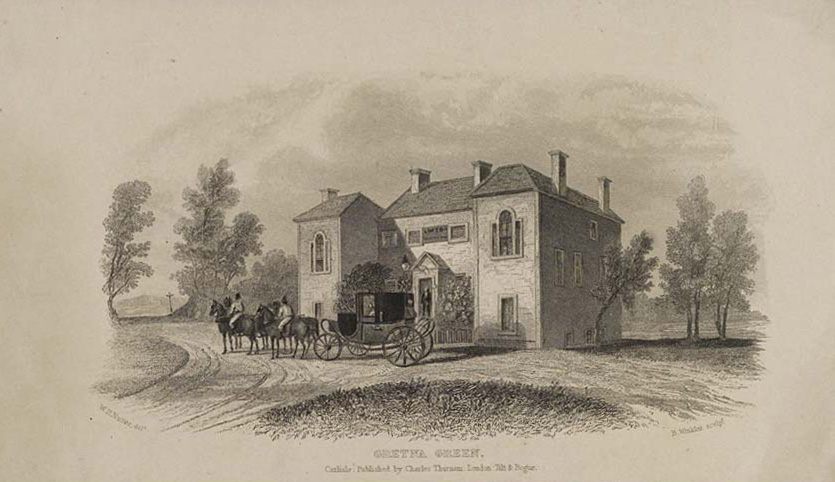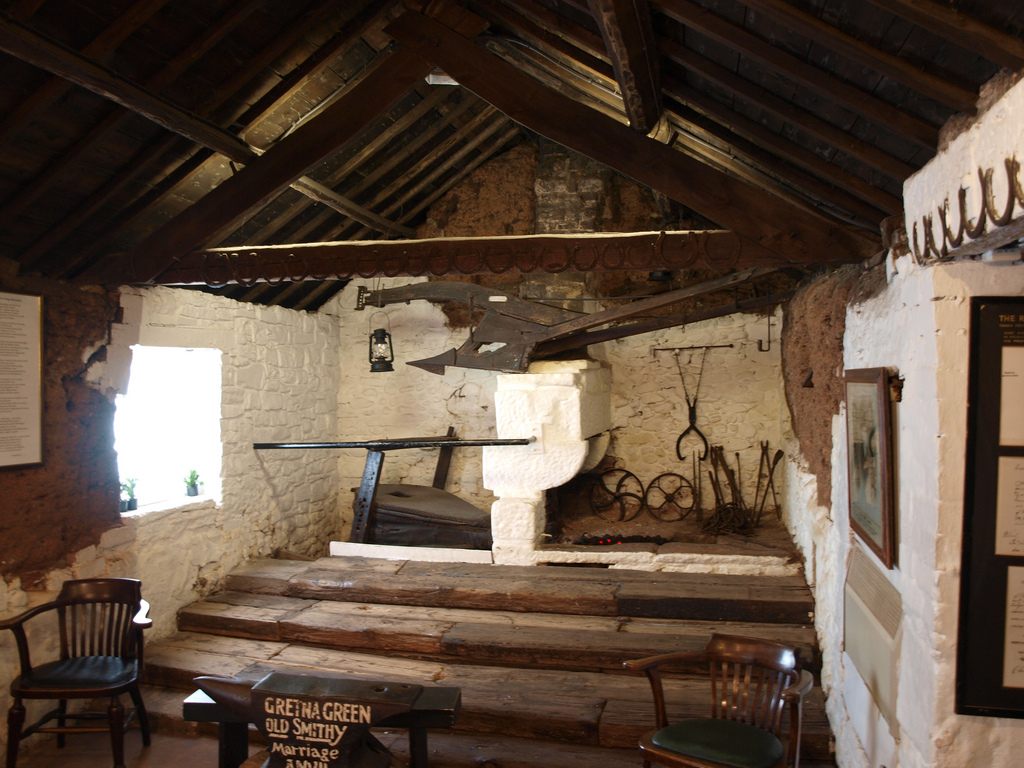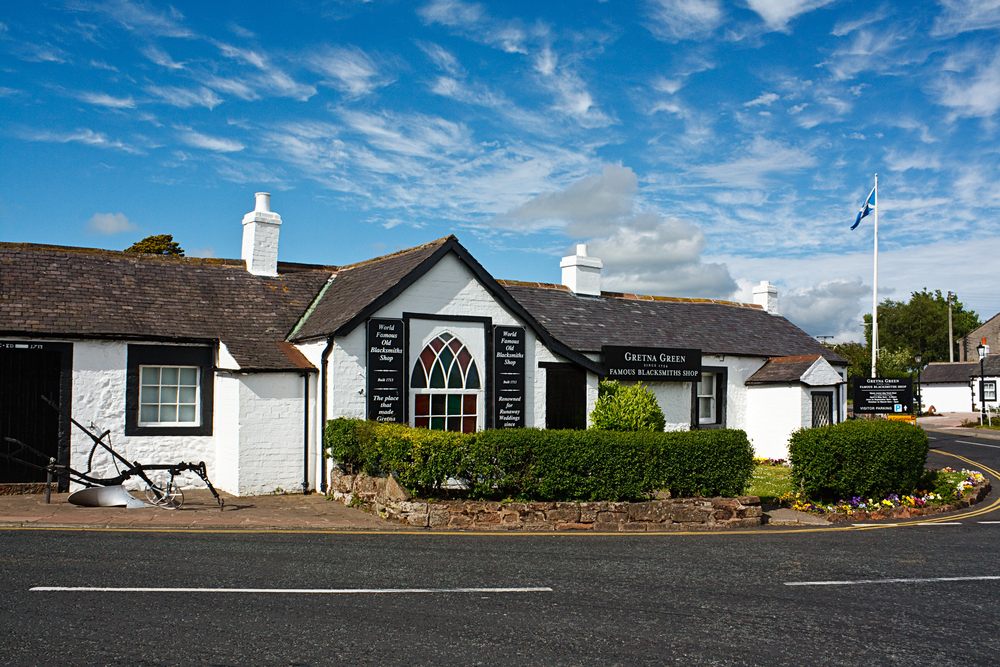For 200 Years, Secret ‘Anvil Weddings’ Were Performed by Blacksmiths in the U.K.
Runaway weddings had blacksmiths, cobblers and mole-catchers as priests.

A marriage over the blacksmith’s anvil in Gretna Green, Scotland. (Photo: Keystone-France/ Gamma-Rapho/ Getty Images)
Love in 18th century England wasn’t the private affair we think of today. When a couple wanted to marry, they not only needed official permission from their parents, but social approval from their whole town. For many English citizens of the era, the only way to live with their sweethearts was to elope in a runaway marriage. Thousands such couples had secret weddings in Scottish border towns each year until the 1940s, often in a decidedly un-romantic venue: the sweaty, stifling shop of the local blacksmith. These ceremonies were known as “anvil weddings.”
Today, most historians agree that fishermen, weavers, and horse saddlers performed most runaway 18th-century weddings rather than blacksmiths, who were highly valued and paid for their trade. “The ‘blacksmith’ is a myth,” English travel writer Charles George Harper wrote in 1907, “deriving no doubt from the more or less poetic idea of indissoluble bonds being forged.”
Yet weddings believed to be unofficial have been referred to as “blacksmith weddings” since the 1500s, and in 1843, a blacksmith from the Scottish border town of Gretna Green wrote to the London Times, asserting that he had performed more than 3,500 weddings.

An 1844 depiction of a wedding at Gretna Green in Scotland, with a blacksmith’s anvil and horseshoes on the wall. (Photo: British Library/Public Domain)
Regardless of who generally performed them, the anvil wedding’s appeal exploded in the 1700s. At the time, English bureaucrats were unsettled by a growing number of marriages done without paperwork, a priest or public license. So the government made written parental permission a legal requirement for young couples, with the Marriage Act of 1753 (full title: An Act for the Better Preventing of Clandestine Marriage).
Under this act non-royal English citizens under 21 couldn’t get married without signed permission from their parents, and had to publicly announce the marriage in their town so others could object if need be. Scotland, on the other hand, had very different laws: girls over 12 and boys over 14 could get married by “declaration,” meaning they only had to announce vows in front of witnesses. Parental permission was not required.
Scottish law allowed any citizen to perform a marriage, and anyone else present to bear witness. Gretna Green innkeeper Thomas Little, who performed weddings in his inn, the Maxwell Arms, is thought to have been the first to capitalize on the legal differences between the two countries, inventing the concept of the “Gretna Wedding.”

An 18th century illustration of Gretna Green. (Photo: National Library of Scotland/CC BY 4.0)
Many runway weddings were performed in inns or public buildings, but another central town fixture also played a chief role: blacksmith cottages, near where the blacksmith made the couple’s rings. Perhaps the most popular blacksmith’s shop for marriages at the time was the smithy of the Scottish estate Gretna Green, conveniently located less than a mile from the border with England, near the River Esk.
Gretna Green became so famous for runaway weddings, that today it is known for little else. Moonlighting priests collected a small fee for their services; the fee sometimes included a room for couples who wanted to consummate the marriage bond straight away. In general, these “anvil weddings” were seen as disreputable, yet very romantic. The “priest,” who had no formal qualifications to lead the wedding, would conclude the marriage ceremony by pounding the anvil in the blacksmith’s shop, symbolically joining the couple the way a blacksmith joins metal.
Runaway weddings were flooded with young lovers and high-status couples who wanted privacy. But anvil weddings were not always forged from pure romance; kidnapped brides were forced to marry at Gretna Green and other border towns, too. One kidnapping that made headlines was “The Shrigley Abduction,” in which the 15-year-old heiress Ellen Turner was captured and coerced into a Gretna Green anvil wedding by 30-year-old Edward Wakefield and his team of accomplices, in order to access her funds (after a court case, the marriage was annulled).

Inside the Gretna Green blacksmith cottage. (Photo: Nigel Swales/CC BY-SA 2.0)
It may not have been common for blacksmiths to conduct anvil wedding ceremonies, but near the turn of the 20th century, entrepreneur Hugh Mackie and his employee Richard Rennison brought the legend to life. In 1890, Hugh Mackie bought Gretna Green and worked as an “anvil priest” (along with his wife), uniting couples by striking his anvil and announcing, “Right-o! Carry on.” When Mackie retired in 1926, Richard Rennison became the blacksmith priest until 1940, when wedding by declaration was outlawed and the authenticity of these marriages were questioned.
Richard Rennison performed more than 5,000 marriages over his blacksmith anvil, some of which were contested but upheld decades later in court. The anvil became so popular some people even threatened to steal it. The popularity of runaway weddings also surged in other Scottish border towns, including toll houses in Lamberton, and Coldstream, where cobblers and “mole catchers” who doubled as priests competed with Gretna Green.
Sometimes it was possible to get married by an actual minister: the coastal village of Portpatrick was home to a minister who ignored Scotland’s marriage law residency requirements in order to wed passengers arriving on a daily ferry route from Northern Ireland. Couples were able to hop off the boat onto land, get married in less than an hour, and then ride the ferry back home in a single day.

The old blacksmith shop at Gretna Green today. (Photo: stocksolutions/shutterstock.com)
In 1856 residency requirements for Scottish weddings put a halt to these marriage ceremonies, naming them invalid unless one member of the couple resided in Scotland (this requirement was removed in 1977). But the difference between the marital laws in Scotland and England still remains: the age of full marriage consent in England is 18, and in Scotland, it’s 16.
Yet the romance of running away to start a new life after a secret wedding at the border has hardly faded. These days couples in both countries have to get a license to make it official, though they can still relive the fantasy of getting married over the anvil.
Like a Scottish Las Vegas, Gretna Green has attracted modern tourists and lovers to its wedding ceremonies for the last few decades, and the blacksmith shop still marries around 1,000 couples per year.










Follow us on Twitter to get the latest on the world's hidden wonders.
Like us on Facebook to get the latest on the world's hidden wonders.
Follow us on Twitter Like us on Facebook